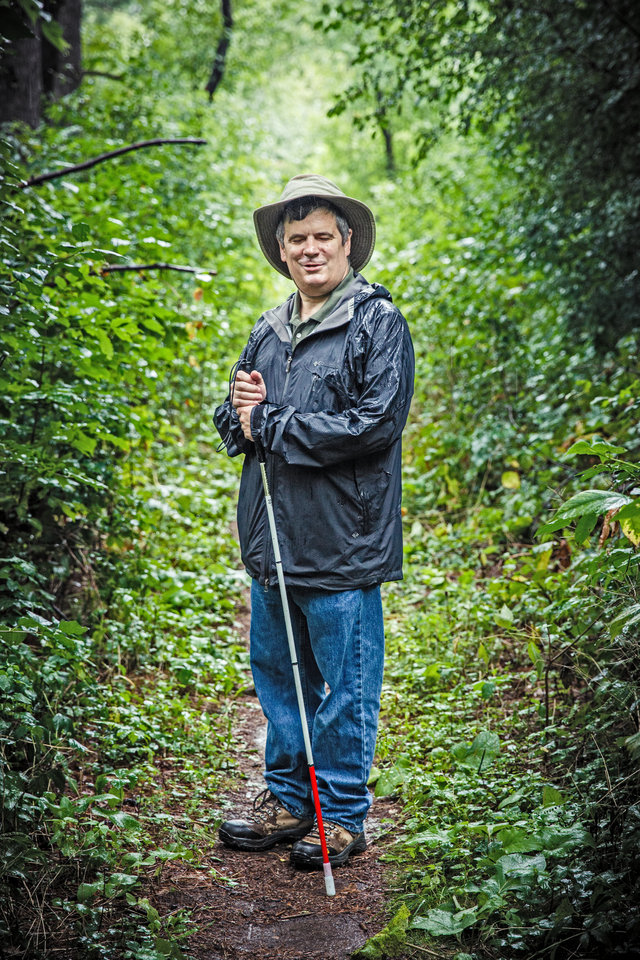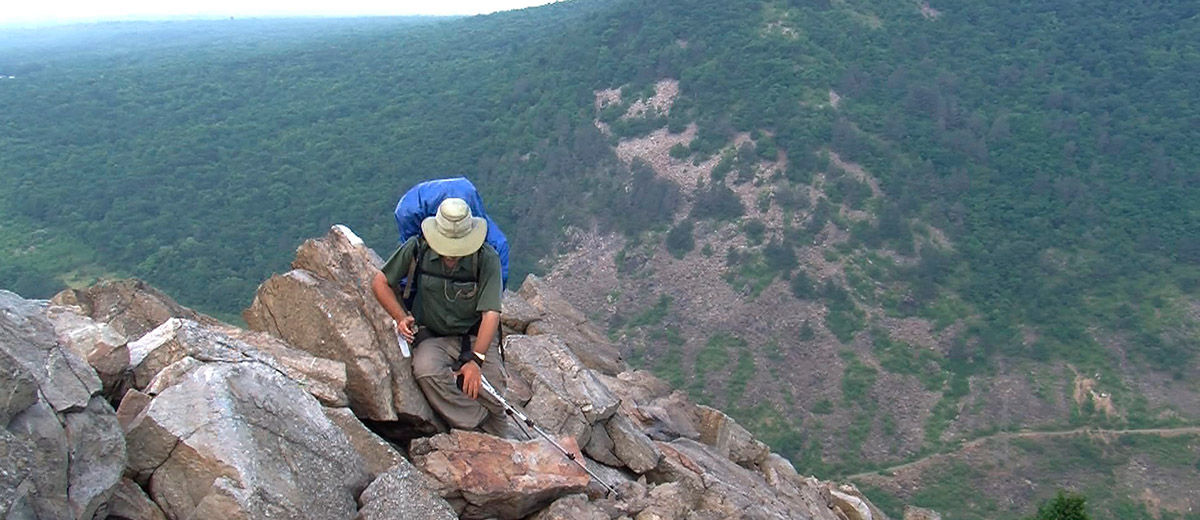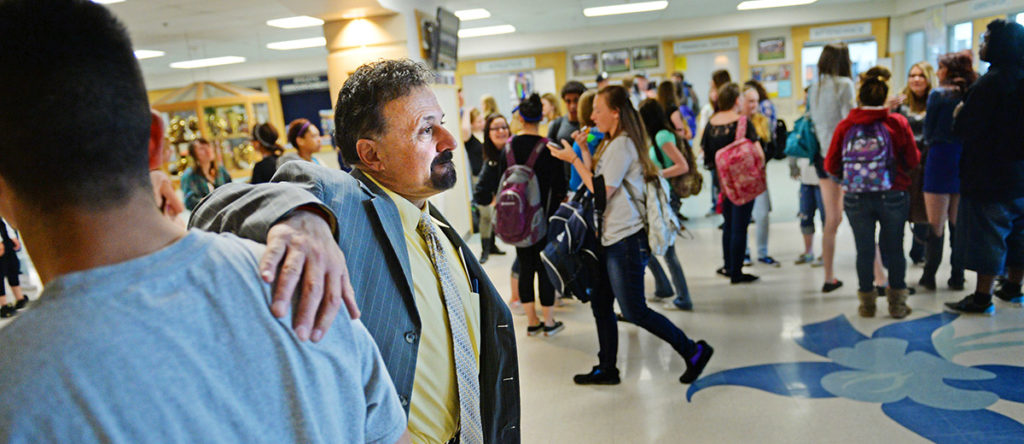In 2006, Mike Hanson had had enough. His marriage was failing. He struggled with underemployment. And too often he sought respite in alcohol.
Hanson is blind. Born three months premature, he has been blind since shortly after birth. Doctors gave him pure oxygen, a common medical practice for preemies until 1954, which destroyed his retinas. To this day, Hanson is not certain why doctors prescribed pure oxygen to a preemie 11 years after Dr. Arnall Patz’s landmark study that directly linked pure oxygen to loss of eyesight in premature infants. He guessed they had no choice but to use it to prevent brain damage.
“I can tell you if the sun is shining on a clear day, but other than that I have no sight,” he explained.
According to the American Foundation for the Blind’s interpretation of a 2010 study by the U.S. Department of Labor’s Bureau of Labor Statistics, of the approximately 2.1 million working-age adults (ages 16-64) who self-identified as having vision loss (either blind or having “serious difficulty seeing even when wearing glasses”) only 38 percent also classified themselves as employed.
“When I do an interview I can guarantee you I’ll spend a lot of time answering illegal questions, like ‘Given your disability how do you type?’ or ‘How do you use a computer?’ Normally they can’t ask you those kinds of questions until after an offer has been made, according to the Americans with Disabilities Act,” he said.
Come what may, he never has been one to dwell on “what ifs,” or recounting tales of all the times his independence has been underestimated.
So, Hanson decided to take a hike, literally, away from the real world. His goal was to hike the roughly 2,180-mile-long Appalachian Trail (called simply the AT by long-trail folks). From the start, the journey would be more than just a personal goal and a break from a demoralizing year. Hanson would plot and complete the majority of the trail unassisted, and in doing so, make a broader statement about the independence of visually impaired people, and the simplicity and usefulness of adaptive technologies, such as GPS, in enhancing their independence.
To document the trip, Hanson invited friend and filmmaker Gary Steffens to join him. Steffens, a self-identified non-outdoorsy person, came on board not to assist or coach Hanson, but to film the hike with the goal of drawing attention to Hanson’s message via a documentary that he would produce on their return.
Three years of preparation
With or without sight, it’s not wise for anyone to embark on a long-distance hike without adequate preparation; accordingly, Hanson spent more than three years preparing for the obvious (terrain, elevation) and the unpredictable (weather, fatigue) – before he arrived at the first trailhead on March 6, 2010, at Springer Mountain in Georgia.
While researching various technologies to assist him in the journey, Hanson discovered a blind-accessible GPS system. The device – which provided voice instruction, stored data and did not require an Internet signal – allowed him to plan routes as well as mark locations and points of interest. He was so impressed with the technology that he continues to use it in his daily life.
Having GPS “meant I could get off a bus for the first time in my life and not have to make educated guesses about where I was and where I wanted to go,” Hanson said. “I could hit a few keys [type in coordinates] on my cell phone and have my route figured out.”
Hanson’s litany of research for the trip – which he anticipated would take seven months – was daunting. After settling on a GPS system, he gathered ample data, which would serve as his eyes, so to speak. He consulted guidebooks to find the names of every town along the AT. Then he compiled a list of every campsite, trailhead, water source, shelter, post office (where he would mail “bounce boxes,” or resupply boxes, containing items too heavy to carry, such as his laptop), grocery store, hostel and other point of interest or necessity – “Everything within a radius of those towns and its proximity to the trail,” he explained.
He also downloaded GPS files on the centerline of the AT from the Appalachian Trail Conservatory’s website. “Then I had to check all of that data against three sources to make sure I was getting accurate data. Sometimes they would lay out sections of trail with no compiled data, and I had to wing it a bit. That’s to be expected. It’s much like when you drive and see a Road Closed or Detour sign,” he said.
Hanson expanded his GPS knowledge with Capable Partners Inc., a Twin Cities-based nonprofit that makes outdoor activities, particularly hunting and fishing, accessible to people with dis- abilities. (Of note, Hanson became CP’s first blind hunter when he joined the organization in 1992.) He became president of CP in 2008, a position he held until 2010, when he set off for the AT.
Amid all of his high-tech preparation, Hanson also researched the old-fashioned way. He had conversations with “thru-hikers” (people who attempt to hike the entire trail) and read guidebooks and nonfiction accounts by people who had hiked it. The most insightful, he said, were A Walk in the Woods by Bill Bryson and Blind Courage by Bill Irwin, who successfully thru-hiked the trail in 1990 with his seeing eye dog, Orient. Irwin remains the first and only blind person to hike the Appalachian Trail alone.
Hanson’s intensity and focus was not lost on his friends, one of whom christened him with the trail name Bulldog because of the dogged nature with which he prepared for the AT. Trail names are hard-earned (and often impish) monikers adopted by or given to thru-hikers, typically after they’ve embarked on the trail. A peek at the Appalachian Trail Conservatory’s website shows that taking a trail name is virtually requisite while hiking the AT. Some choice names from past AT thru-hikers include Stormin’ Mormon, Gluten Puff and Acid Glasses.

Mike Hanson. (Photo by Mark Brown)
True grit
As an observer, Steffens (trail name Hitchcock), couldn’t help but be awestruck by Bulldog’s indefatigable attitude. “I used to be a psychologist and counselor. I had a sense he – to use a John Wayne analogy, because Mike loves John Wayne – had the ‘true grit’ to get through this,” he said. Once on the trail,
Hanson would discover that even three years of preparation would take him only so far, and he’d need to tap every ounce of grit he could muster.
At nearly 2,180 miles long, the Appalachian Trail is one of the longest continuous trails in the world. It snakes through 14 states, from Georgia to Maine, and hosts between 2 and 3 million people who hike portions of the trail each year. Only a fraction of these visitors attempt to thru-hike the entire trail. Only one in four of those succeed, compliments of the extreme weather − everything from blizzards to 100-plus degree heat − and a total elevation gain that is the equivalent to climbing Mount Everest 16 times.
When Hanson and Steffens finally stepped onto the trail, there was no doubt that this was Hanson’s journey.
With GPS, knowing his location or where he was going often was the easy part. The tricky part for Hanson was navigating through terrain that, at times, was treacherously slippery, steep, rocky, or all three at once. “Steffens did not coach me,” Hanson clarified, “unless the situation was highly dangerous or unusual enough that it would be much faster to coach me through it.”
For weeks and months at a time he traversed dangerous rock formations and trails that would have challenged even experienced hikers.
One of the most harrowing experiences occurred in Pennsylvania, where Hanson climbed Lehigh Gap, a.k.a. “Dante’s Inferno.” The trail narrows and runs along a steep, exposed rock face with dangerous ledges. In 100-degree heat and high humidity, he proved his true grit by vertical scrambling up a fairly serious drop. Hanson described the section “like a moonscape,” as it was void of all living vegetation from extensive zinc mining. In fact, the northern part of the state is so rocky, it is known among AT hikers as “Rocksylvania.”
With every step, he felt around for footholds small enough to solidly accommodate the tips of his boots. “My hands got a workout when I had to do that,” he said of the white-knuckle ascent.
Even with all his planning, the relentlessly grueling nature of the trail and conditions left very little time for self-reflection. (He did, however, manage to keep a journal because he planned to write a book on his experience after he finished.)
“Honestly, all I thought about was what was beneath my feet, and where the handholds and footholds were if we were scrambling up a rock face,” Hanson said.
Trail of angels
A critical and affectionate part of the long-distance-hiking community is the role of “trail angels.” In long-distance hiking parlance a trail angel is a person who dispenses “trail magic,” a random act of kindness to a fellow hiker in need, often when the hiker needs it most. In place of wings, these angels of the wilderness are more likely to don aluminum-framed backpacks.
On a 2,000-plus-mile trip, trail magic often springs among passing hikers when one is in need of a favor or help. A dozen or so trail angels, by Hanson’s memory, offered many favors, from giving him a lift to the nearest motel or hiker hostel where he could rest and find a good meal, to offering advice on protein intake (i.e. canned Vienna sausages).
Perhaps, the most poignant example of angelic intervention took place at Maine’s notorious Mahoosuc Notch, considered by most AT hikers to be the toughest mile on the trail. It was the only section for which Hanson required, for his safety, assistance carrying his backpack.
The mile-long notch was formed by boulders that had fallen from the sides of two adjacent mountains into a narrow “V” between them. The Appalachian Trail runs through it. Steffens said, “hikers must climb over, around and sometimes through [as in tunnels] heaped boulders ranging from sofa-size to larger than a house.”
It takes sighted hikers two hours, on average, to traverse. For Hanson, who used his hands, feet and trekking poles to navigate and fend off any hike-ending injuries, the stretch took nine-and-a-half hours. Three angels − trail-named Unicroc, Scat Tracker and Dune − auspiciously crossed Hanson’s path at the beginning of the jungle gym of boulders and saw him through it from start to finish.
With the three trail angels coaching Hanson (including Unicroc who scrambled ahead with Hanson’s backpack in three intervals, returning to the group after each leg to offer guidance), Steffens was free to capture the feat on film.
“I now know what it’s like to be strained through a sieve,” Hanson recalled of the ordeal. “I hoped whoever was helping knew which hole they were picking and I just went with it. They all helped me at one time or another getting through those crazy holes.”
Maine and New Hampshire are famous for their “White Mountains” section, marked by “high alpine peaks, dramatic weather changes and no tree cover,” Hanson noted. Both states also are touted by the Appalachian Trail Conservatory as the most difficult on the trail. The area lived up to its hype many times over.
Hanson encountered almost horizontal rain and 45 mph winds climbing up Mount Moosilauke in New Hampshire at the end of August. “You needed to yell to be heard,” Hanson said. Luckily, the winds were “only” around 30 mph when they arrived at the top of Mount Washington, where winds were recorded at a scant 234 mph in 1934.
“Mike’s capacity to keep going month after month was amazing,” Steffens said. Given the conditions, “You’d think this film would be pretty bleak, but it’s pretty funny because he’s great at one liners.
“You’d be amazed how he could keep doing it with a sense of humor. When we were climbing Mount Moosilauke, which goes next to a waterfall and river for the whole extent of it, he said ‘I’m always on my knees on this mountain either climbing or praying. I don’t know which!’”

The Appalachian Trail (Map by Shannon Nowak)
Off-trail magic
In a magical twist of irony, Hanson had to cut his trip short near the tail end after hiking 1,700 of the 2,180 miles when he received an invitation from Harlan Jacobs, a friend he made prior to his hike, to join a start-up business.
Hanson had just finished climbing Mount Katahdin, Maine’s highest mountain at 5,269 feet and the physical end point of the AT. He was forced to skip a portion of the Smoky Mountains to beat severe weather that would have kept him off of Katahdin until spring, which was not an option. After completing Katahdin, he had planned to go back and hike the portion of the Smokey Mountains he had missed. It would be another six to eight weeks of hiking before he could say he had completed the trail.
The name of Hanson and Jacobs’ business, fittingly, is named Wayfinder Angel Corp.
“We have a great invention that will take people with visual impairments to the next level,” Hanson said. “It’s going to be a device that a user will wear − one or more camera lenses mounted to glasses or something similar. The end result will be like OnStar for visually impaired people.”
The device will fill the gaps left by GPS. Users will talk to a live person if they, for instance, arrived at an address where the entrance was located on the side of the building. They will be able to ask for immediate assistance navigating buildings or roundabouts, which are tricky even to sighted pedestrians.
In many ways, Hanson set out on the Appalachian Trail with hopes of stirring up some off-trail magic for others who have a visual impairment, so that they will be able to pursue their dreams. And also that potential employers will become more open to seeing that visually impaired people can be valuable contributors to the workplace. He’s hesitant to admit he succeeded in his goals, but since his return he’s been spreading his message in lectures and to media when the opportunities arise. He also wrote and published a book on his experience, The Unseen Trail: The Story of a Blind Hiker’s Journey on the Appalachian Trail (Birch Grove Publishing). And Steffens’ documentary, “Blind ‘Bulldog’ Hanson: Appalachian Trail Odyssey” is in the final stages of editing.
“Things have reached an interesting point,” Hanson wrote in his book, “Most persons with disabilities can find technology to work around many limitations, yet the problem is often convincing other people that we can work around perceived limitations.”
The experience is still fresh for the one person who witnessed Hanson’s determination firsthand. “It’s hard totalk about how [Mike] grew or changed over the course of those months because [the hike] was tremendously grueling,” Steffens said. “For six and a half months we got up and ground out as many miles as we could, day after day. But what was so incredible about Mike is that every day he did it, and that was over tough terrain in very tough, dangerous conditions. It’s remarkable for a sighted person, but to pick over it with two canes ... .”
Hanson credits his “outdoorsy” parents for teaching him to prosper in nature in spite of his limitations. The oldest of three brothers, Hanson has enjoyed fishing and camping since he was a child. He’s also been a hunter (with a seeing companion) since he was 12 – Minnesota’s legal hunting age. Among his most prized trophies is a 900-pound, seven-by-six bull elk.
So is the outdoorsy “Bulldog” up for another long-distance hike, perhaps the AT’s sister, the Pacific Crest Trail? “No!” he replied emphatically. “I had a great time and have no regrets, but I’ll never again take for granted a hot shower, refrigeration and a roof over my head.”
Read more from St. Thomas magazine.







